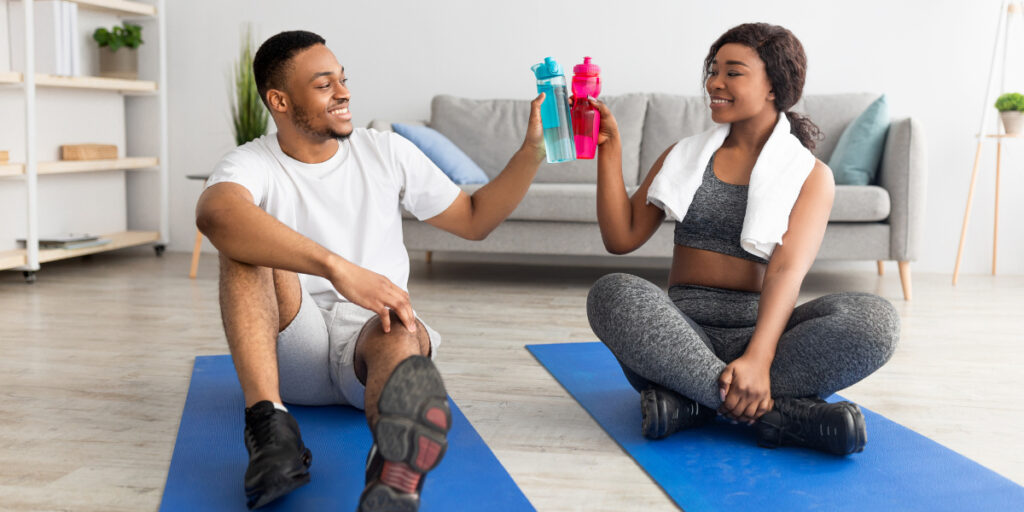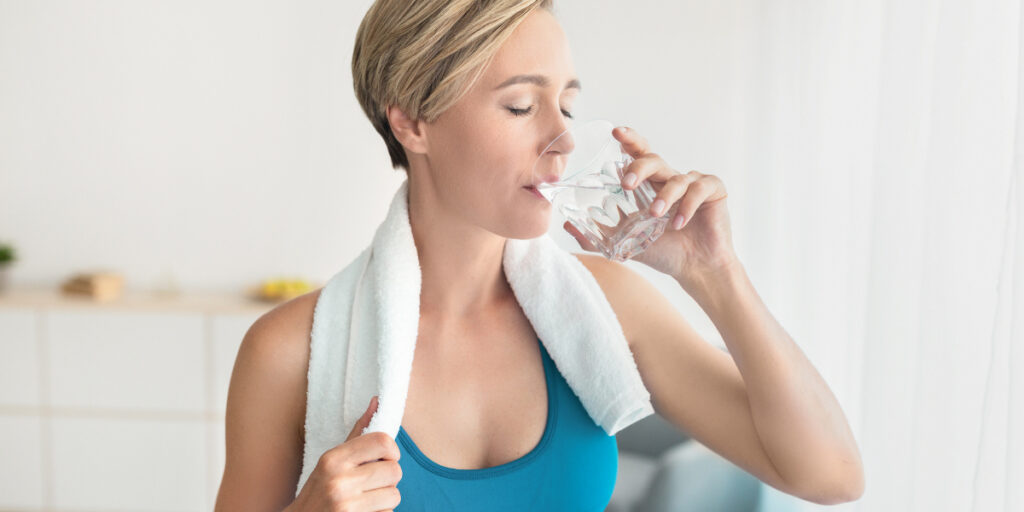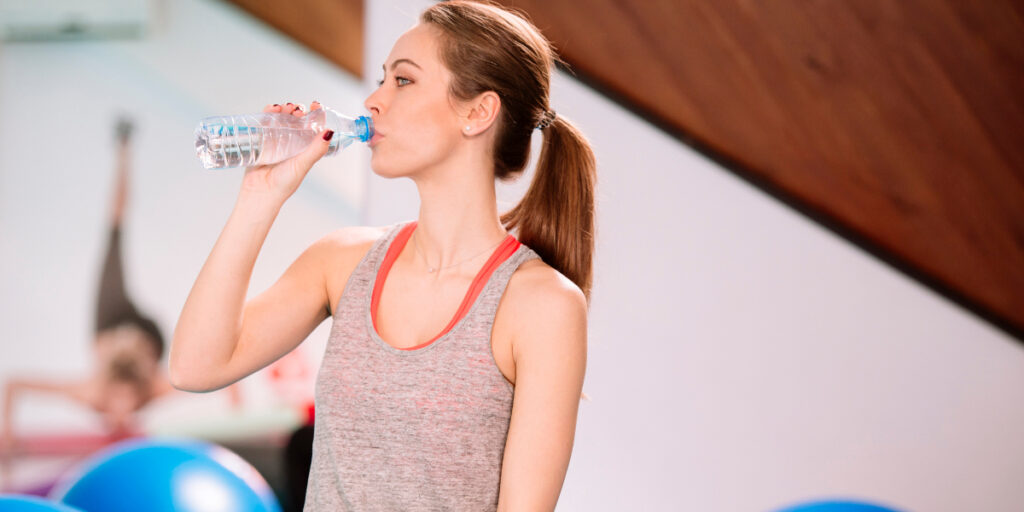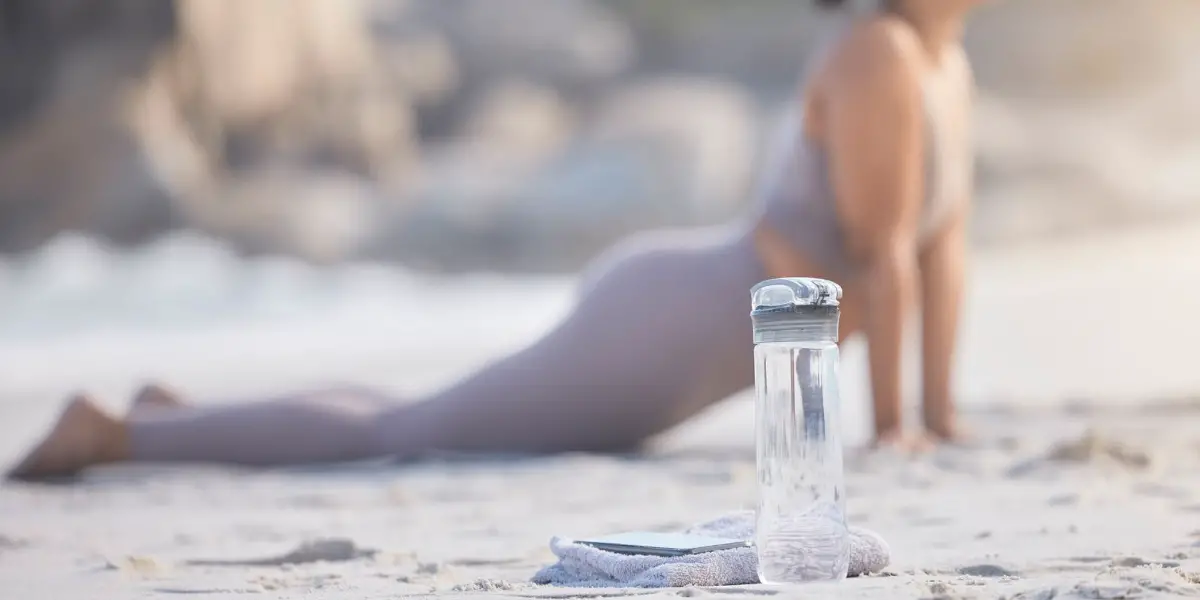Pilates is a popular exercise focusing on developing strength, flexibility, and control through slow movements. While Pilates is a low-impact exercise, it still requires a certain hydration level to optimize performance and prevent injury. Hydration is crucial to maintaining the body’s internal balance and ensuring that muscles and organs function at their best.
To hydrate for Pilates, drink water before, during, and after your session. Aim for 8-16 oz of water 30 minutes before, sips throughout, and at least 8 oz after. Avoid caffeine and alcohol, which can dehydrate you. Monitor urine colour; clear or pale yellow is optimal.
This article will explore the importance of hydration for Pilates, its role in improving performance, and how to stay properly hydrated during your Pilates practice. Whether you’re a beginner or an experienced Pilates practitioner, understanding the importance of hydration is essential to optimizing your performance and getting the most out of your Pilates practice. So, let’s dive in and learn everything you need to know about hydrating for Pilates.
The Importance of Hydration for Pilates
Proper hydration is critical for optimal performance and safety during Pilates practice. When you exercise, your body sweats to regulate your internal temperature, losing fluids that need replenishment. Dehydration can lead to negative consequences, including decreased energy, impaired mental focus, muscle cramps, and fainting. In addition to these risks, dehydration can reduce the effectiveness of your Pilates practice and lead to a less satisfying experience overall.
Hydration is crucial in maintaining your body’s internal balance, including delivering nutrients and oxygen to your muscles and organs. When you’re properly hydrated, your body can function more efficiently, and your muscles are better able to perform the controlled, deliberate movements that Pilates requires. By understanding the importance of hydration for Pilates, you can take steps to ensure that you stay hydrated and get the most out of your practice.

How hydration affects your Pilates performance
Hydration has a direct impact on your Pilates performance. When dehydrated, your body has to work harder to perform the same movements, leading to decreased energy levels and impaired muscle function. Your body also relies on fluids to transport nutrients and oxygen to your muscles, which is crucial for optimal performance and recovery.
Without proper hydration, you may experience muscle cramps, decreased range of motion, and reduced flexibility, all of which can interfere with your Pilates practice. Additionally, dehydration can impair your mental focus and reaction time, making it harder to perform the precise, controlled movements that Pilates requires.
By staying hydrated, you can ensure your body is functioning at its best and get the most out of your Pilates practice. Proper hydration can improve your energy levels, enhance your muscle function and flexibility, and help you maintain mental clarity throughout your practice. So, make sure to prioritize hydration to optimize your Pilates performance.
The risks of exercising without proper hydration
Exercising without proper hydration can be dangerous and lead to various negative consequences. Dehydration can cause muscle cramps, dizziness, headaches, and fatigue, interfering with your ability to perform Pilates safely and effectively. In severe cases, dehydration can lead to heat exhaustion or heatstroke, which can be life-threatening.
Dehydration can also cause a decrease in blood pressure, which can lead to fainting or loss of consciousness. This can be especially dangerous during Pilates practice, where you are often in positions that require balance and stability.
In addition to these physical risks, exercising without proper hydration can negatively impact your mental focus and reaction time. This can make it harder to perform the precise, controlled movements Pilates requires, leading to a less satisfying experience overall.
To avoid these risks, it’s essential to prioritize hydration before, during, and after your Pilates practice. This will help ensure that your body is functioning at its best and that you can perform Pilates safely and effectively.

Understanding Your Hydration Needs for Pilates
To stay properly hydrated during Pilates, it’s important to understand your body’s individual hydration needs. Factors such as age, weight, and gender can impact how much water you need, as can the temperature and humidity of your environment. In general, it’s recommended that you drink 8-16 ounces of water 30 minutes before your Pilates practice and continue to sip water throughout your session.
During Pilates practice, listening to your body and drinking water as needed is important. You may not feel thirsty, but your body still needs fluids to perform at its best. After Pilates, it’s important to continue hydrating to replace any fluids lost during practice.
Monitoring the colour of your urine can also help you determine if you’re properly hydrated. Clear or pale yellow urine is a sign of good hydration, while dark yellow or amber urine indicates that you need more water.
Understanding your individual hydration needs and taking steps to stay properly hydrated can optimize your Pilates performance and get the most out of your practice. So, prioritize hydration and listen to your body to stay on top of your hydration needs during Pilates practice.
How much water do you need before, during, and after Pilates?
The water you need before, during, and after Pilates practice can vary depending on several factors. As a general guideline, it’s recommended to drink 8-16 ounces of water 30 minutes before your Pilates session to ensure that your body is properly hydrated before you begin.
During your Pilates practice, taking small sips of water as needed is recommended to replenish any fluids lost through sweating. After your practice, it’s important to continue hydrating to replace any fluids lost during exercise.
The table below provides a general guideline for how much water you should aim to drink before, during, and after Pilates practice based on your body weight:
| Body Weight | Before Pilates | During Pilates | After Pilates |
| 100 lbs | 12-24 oz | 4-8 oz | 16-20 oz |
| 150 lbs | 18-32 oz | 6-12 oz | 24-30 oz |
| 200 lbs | 24-40 oz | 8-16 oz | 32-40 oz |
Keep in mind that these are just general guidelines, and your individual hydration needs may vary depending on factors such as age, gender, and the intensity of your Pilates practice. It’s important to listen to your body and drink water to stay hydrated during your Pilates practice.
The impact of temperature and humidity on hydration needs
Temperature, and humidity can significantly impact your body’s hydration needs during Pilates practice. When the temperature or the humidity is high, your body will sweat more to regulate its internal temperature, leading to a higher risk of dehydration.
In these conditions, staying properly hydrated before, during, and after your Pilates practice is especially important. This may mean drinking more water than in cooler or less humid conditions, as your body will lose more fluids through sweating.
Suppose you’re practising Pilates in hot or humid conditions. In that case, you may also need to take additional measures to stay hydrated, such as drinking electrolyte-rich beverages or eating foods high in water. It’s also important to listen to your body and take breaks to rest and rehydrate.
By understanding the impact of temperature and humidity on your hydration needs, you can take steps to stay properly hydrated during your Pilates practice, even in challenging conditions. So, consider the environmental factors when planning your hydration strategy and adjust your approach accordingly.
The importance of individualized hydration plans
While there are general guidelines for how much water you should drink before, during, and after Pilates, it’s important to recognize that everyone’s hydration needs are different. Age, weight, and gender can impact how much water you need, as can the intensity and duration of your Pilates practice.
To stay properly hydrated during Pilates, it’s important to develop an individualized hydration plan that considers these factors. This may mean increasing your water intake before, during, and after your Pilates practice or incorporating electrolyte-rich beverages to help replenish lost fluids.
Listening to your body and adjusting your hydration plan are also important. If you’re feeling thirsty or exhausted, it may indicate that you need to drink more water. Conversely, you may be drinking too much if you’re experiencing frequent bathroom breaks or feeling bloated.
By developing an individualized hydration plan and paying attention to your body’s signals, you can optimize your Pilates performance and ensure you stay hydrated properly. So, make sure to take your individual needs into account when planning your hydration strategy and adjust your approach as needed.
Hydration Strategies for Pilates
To stay properly hydrated during Pilates, it’s important to develop a hydration strategy that considers your individual needs and the specifics of your Pilates practice. Here are some hydration strategies to consider:
- Start Hydrating Early: Drink water throughout the day leading up to your Pilates practice to ensure that you start your practice hydrated.
- Drink Before, During, and After Pilates: Aim to drink 8-16 ounces of water 30 minutes before your Pilates session and continue sipping water throughout your practice. After practice, continue to hydrate to replace any fluids lost during exercise.
- Monitor Urine Colour: Check the colour of your urine to assess your hydration status. Clear or pale yellow urine is a sign of good hydration, while dark yellow or amber urine indicates that you need more water.
- Consider Electrolyte-Rich Beverages: If you’re exercising in hot or humid conditions or for an extended period, you may need to replenish lost electrolytes and fluids. Sports drinks or coconut water can help replenish electrolytes.
- Eat Hydrating Foods: Besides drinking water, eating hydrating foods like fruits and vegetables can help you stay hydrated.
By developing a hydration strategy that works for you and staying properly hydrated, you can optimize your Pilates performance and get the most out of your practice. So, experiment with different hydration strategies to find what works best for you and prioritize hydration in your Pilates practice.
Preparing your body for Pilates through hydration
Proper hydration before your Pilates practice is essential for preparing your body for exercise. Drinking water before Pilates helps ensure that your body is properly hydrated, which can help prevent muscle cramps and fatigue during your practice. It can also help you maintain focus and mental clarity, making it easier to perform the precise, controlled movements that Pilates requires.
To prepare your body for Pilates through hydration, aim to drink 16-20 ounces of water 2-3 hours before your practice. This will give your body enough time to properly absorb the water and hydrate your muscles. You can also drink another 8-16 ounces of water 30 minutes before practice to ensure your body is fully hydrated.
In addition to drinking water, consider eating hydrating foods like fruits and vegetables to help boost your hydration levels before your Pilates practice. This will help you stay hydrated and provide your body with the nutrients it needs to perform at its best.
Hydration strategies during Pilates practice
Staying hydrated during Pilates practice is essential for maintaining energy levels, preventing muscle cramps, and ensuring that your body can perform at its best. Here are some hydration strategies to consider during your Pilates practice:
- Take Small Sips of Water: During your Pilates practice, take small sips of water as needed to replenish lost fluids. You may not feel thirsty, but your body still needs fluids.
- Use a Hydration Pack: Consider using a hydration pack or water bottle with a straw to make it easier to sip water during your Pilates practice. This will help you stay hydrated without interrupting your practice.
- Monitor Your Urine Colour: Check the colour of your urine to assess your hydration status. Clear or pale yellow urine is a sign of good hydration, while dark yellow or amber urine indicates that you need more water.
- Eat Hydrating Foods: Eating hydrating foods like fruits and vegetables during your Pilates practice can also help you stay hydrated.
- Avoid Caffeine and Alcohol: Caffeine and alcohol can dehydrate you, so it’s best to avoid these beverages before and during your Pilates practice.

How to rehydrate after Pilates
Proper rehydration after Pilates is essential for replenishing lost fluids and ensuring that your body can recover properly. Here are some tips for rehydrating after your Pilates practice:
- Drink Water: Drink 16-20 ounces immediately after your Pilates practice to begin rehydrating your body.
- Monitor Your Urine Colour: Check the colour of your urine to assess your hydration status. Clear or pale yellow urine is a sign of good hydration, while dark yellow or amber urine indicates that you need more water.
- Consider Electrolyte-Rich Beverages: If you’ve been exercising for an extended period or in hot and humid conditions, you may need to replenish lost electrolytes and fluids. Sports drinks or coconut water can help replenish electrolytes.
- Eat Hydrating Foods: Hydrating foods like fruits and vegetables can also help you rehydrate after your Pilates practice.
- Drink More Water Throughout the Day: After your Pilates practice, drink water to replace any fluids lost during exercise.
By following these tips for rehydration after your Pilates practice, you can ensure that your body is properly replenished and ready for your next practice. So, prioritize hydration after your Pilates practice to support optimal recovery and performance.
Foods and Drinks That Hydrate
In addition to drinking water, several foods and drinks can help you stay hydrated throughout your day, including:
- Fruits: Many fruits, such as watermelon, strawberries, and cantaloupe, are high in water content and can help you stay hydrated.
- Vegetables: Vegetables like cucumbers, celery, and lettuce are also high in water content and can contribute to your daily hydration needs.
- Soups and Broths: Soups and broths are excellent sources of hydration, especially during colder months. Clear soups like chicken noodles or vegetable broth can help you stay hydrated while also providing nourishment.
- Herbal Tea: Herbal teas, like peppermint or chamomile, are a good way to hydrate while providing other health benefits.
- Electrolyte-Rich Beverages: Sports drinks, coconut water, and other electrolyte-rich beverages can help replenish lost fluids and electrolytes during exercise or in hot and humid conditions.
The best drinks for Pilates hydration
Staying properly hydrated during Pilates practice is essential for maintaining energy levels, preventing muscle cramps, and ensuring that your body can perform at its best. Here are some of the best drinks for Pilates hydration:
- Water: Drinking water is the simplest and most effective way to stay hydrated during Pilates practice. Aim to drink 8-16 ounces of water 30 minutes before practice and continue sipping water throughout your session.
- Coconut Water: Coconut water is a natural source of electrolytes and can help replenish lost fluids during Pilates practice.
- Sports Drinks: Sports drinks like Gatorade or Powerade contain electrolytes and carbohydrates that can help replenish fluids and provide energy during extended Pilates sessions.
- Herbal Tea: Herbal teas, like ginger or peppermint, can help you stay hydrated while providing other health benefits like calming an upset stomach or reducing inflammation.
- Infused Water: Infusing your water with fruits, like lemon or cucumber, can add flavor and additional nutrients to help you stay hydrated.
Foods that contribute to hydration
In addition to drinking water and other hydrating beverages, several foods can help you stay hydrated throughout your day. Here are some foods that contribute to hydration:
- Watermelon – is a refreshing and hydrating fruit of over 90% water. It’s also a good source of vitamins A and C.
- Cucumber – is a crunchy and hydrating vegetable with low calories. It’s a good source of vitamin K and can be eaten as a snack or added to salads.
- Celery – is another hydrating vegetable with low calories. It’s a good source of fiber and can be eaten raw as a snack or added to soups and stews.
- Strawberries – are a sweet and hydrating fruit that’s also a good source of vitamin C. They can be eaten as a snack or added to smoothies and salads.
- Broth – like chicken or vegetable broth, is a hydrating liquid that’s also a good source of protein. It can be used as a base for soups and stews or as a warm, comforting drink.
Supplements and sports drinks for Pilates hydration
Supplements and sports drinks can be useful for replenishing lost fluids and electrolytes during Pilates practice, especially in hot and humid conditions or during extended exercise sessions. Some supplements and sports drinks to consider for Pilates hydration:
- Electrolyte Supplements: Electrolyte supplements, like Nuun tablets or Skratch Labs Hydration Mix, can help replenish lost electrolytes during exercise. You can add these supplements to water or other fluids to support additional hydration.
- Coconut Water: Coconut water is a natural source of electrolytes and can be a hydrating alternative to sports drinks.
- Sports Drinks: Sports drinks like Gatorade or Powerade contain electrolytes and carbohydrates that can help replenish fluids and provide energy during extended Pilates sessions.
- BCAA Supplements: Branched-chain amino acid (BCAA) supplements can help reduce muscle fatigue and improve recovery during and after Pilates practice.
- Magnesium Supplements: Magnesium supplements can help regulate fluid balance in the body and support proper muscle function during Pilates practice.
Hydration Tips for Optimal Pilates Performance
Proper hydration is essential for optimal Pilates performance. Here are some hydration tips to help you perform at your best:
- Start Hydrating Early: Drink water throughout the day leading up to your Pilates practice to ensure that you start your practice hydrated.
- Monitor Urine Colour: Check the colour of your urine to assess your hydration status. Clear or pale yellow urine is a sign of good hydration, while dark yellow or amber urine indicates that you need more water.
- Drink Before, During, and After Pilates: Aim to drink 8-16 ounces of water 30 minutes before your Pilates session and continue sipping water throughout your practice. After practice, continue to hydrate to replace any fluids lost during exercise.
- Consider Electrolyte-Rich Beverages: If you’re exercising in hot or humid conditions or for an extended period, you may need to replenish lost electrolytes and fluids. Sports drinks or coconut water can help replenish electrolytes.
- Eat Hydrating Foods: Besides drinking water, eating hydrating foods like fruits and vegetables can help you stay hydrated.
- Listen to Your Body: If you’re feeling thirsty or tired during your Pilates practice, it may be a sign that you need to drink more water. Conversely, you may be drinking too much if you’re experiencing frequent bathroom breaks or feeling bloated.
Monitoring your urine colour for hydration status
Your urine colour can be a helpful indicator of your hydration status. Checking the colour of your urine can help you assess whether you’re properly hydrated or need to drink more water. Here’s what different urine colours may indicate:
- Clear or Pale Yellow: Clear or pale yellow urine is a sign of good hydration. If your urine is this colour, it indicates that you’re well-hydrated and your body is functioning properly.
- Dark Yellow or Amber: Dark yellow or amber urine can indicate that you’re dehydrated and need to drink more water. This colour may indicate concentrated urine, leading to kidney stones or urinary tract infections.
- Orange: Orange urine can indicate dehydration or a liver or bile duct condition. If you notice that your urine is consistently orange, it’s important to consult with a healthcare professional.
- Brown: Brown urine can indicate dehydration or a more serious underlying condition, such as liver disease or muscle breakdown. If your urine is consistently brown, seeking medical attention is important.
By monitoring your urine colour, you can gain insight into your hydration status and take steps to stay properly hydrated throughout your day. So, make sure to pay attention to the colour of your urine and make hydration a priority for optimal health and wellness.
How to tell if you’re dehydrated during Pilates?
During Pilates practice, staying hydrated is crucial to avoid muscle cramps, fatigue, and decreased focus. Dehydration can occur when the body loses more fluids than it takes in, leading to an imbalance in the body’s electrolytes and affecting performance. Here are some signs that you may dehydrate during Pilates:
One of the most common signs of dehydration is feeling thirsty. If you’re feeling thirsty during your Pilates practice, drinking water or another hydrating beverage is important.
Another indicator of dehydration is dark-coloured urine. If you notice that your urine is dark yellow or amber, it may indicate that you need more water. Also, dehydration can cause fatigue and decreased energy levels, making it difficult to complete your Pilates routine. If you’re experiencing a headache during your practice, it may also indicate that you need to hydrate.
Other signs of dehydration during Pilates can include dizziness, dry mouth, and muscle cramps. If you experience any of these symptoms, it’s important to immediately drink water or another hydrating beverage to rehydrate the body and prevent further complications.
Tips for staying hydrated outside of Pilates practice
Proper hydration is essential for overall health and well-being, not just during Pilates practice. Here are some tips for staying hydrated throughout your day:
- Drink Water Throughout the Day: Aim to drink at least eight glasses daily to stay hydrated.
- Eat Hydrating Foods: Incorporate hydrating foods like watermelon, cucumber, and celery into your diet to supplement your hydration needs.
- Keep a Water Bottle Handy: Bring a refillable water bottle wherever you go to make it easier to stay hydrated throughout the day.
- Monitor Your Urine Colour: Check the colour of your urine to assess your hydration status. Clear or pale yellow urine is a sign of good hydration, while dark yellow or amber urine indicates that you need more water.
- Avoid Dehydrating Beverages: Limit your intake of dehydrating beverages like alcohol, coffee, and soda.
- Set Reminders: Set reminders on your phone or computer to remind you to drink water throughout the day.
Sources:
- https://www.medicinenet.com/what_color_urine_indicates_dehydration/article.htm
- https://my.clevelandclinic.org/health/diseases/21517-dehydration-headache
- https://www.healthline.com/nutrition/19-hydrating-foods
- https://www.eatright.org/health/essential-nutrients/water/how-much-water-do-you-need
- https://www.betterhealth.vic.gov.au/health/healthyliving/Exercise-the-low-down-on-water-and-drinks




